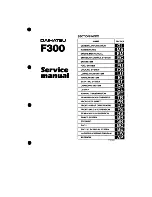
STARTING AND DRIVING
}}
443
Slippery driving conditions
To help optimize traction and roadholding,
Volvo recommends using snow tires on all
wheels whenever there is a risk of snow or ice
on the road.
Certain countries require use of winter tires
by law. Not all countries permit the use of
studded tires.
Practice driving on slippery surfaces under
controlled conditions to learn how the vehicle
reacts.
Related information
•
•
•
Braking on salted roads (p. 410)
•
•
•
•
Replacing windshield wiper blades
(p. 648)
•
Changing rear window wipers (p. 647)
•
Driving through standing water
It may be necessary to drive the vehicle
through standing water, e.g. deep puddles or
flooding on the road. This must be done with
great caution.
To help prevent damage to the vehicle when
driving through water:
•
Do not drive in water higher than the floor
of the vehicle. If possible, check the depth
of the water at its deepest point before
driving through it. Be particularly careful
when driving through flowing water.
•
Always select the
Off Road
drive mode
before driving in water to ensure the gaso-
line engine is running.
•
Do not drive faster than walking speed.
•
Do not stop the vehicle in the water. Drive
carefully forward or back the vehicle out of
the water.
•
Remember that waves created by passing
vehicles could cause the water level to rise
above the vehicle's floor level.
•
Avoid driving through salt water to help
avoid the risk of corrosion.
Parts of the vehicle (e.g. engine, transmis-
sion, driveline, electrical components, etc.)
can be damaged if the vehicle is driven
through water higher than its floor level.
Damage to any components caused by
flooding, vapor lock or insufficient oil is not
covered under warranty.
If the engine stalls while the vehicle is in
water, do not attempt to restart it. Have
the vehicle towed on the bed of a tow
truck to a workshop - an authorized Volvo
workshop is recommended.
Because it can be difficult to determine the
water depth, Volvo recommends not driv-
ing through standing or running water. The
driver is always responsible for operating
the vehicle in a safe manner and adhering
to all applicable laws and regulations.
When you have passed the water, press lightly
on the brake pedal and check that the brakes
are functioning properly. Water, mud, slush,
etc. can make the brake linings slippery,
resulting in delayed braking effect.
If the vehicle is equipped with a trailer cou-
pling contact, clean the contact after driving in
water or mud.
Summary of Contents for S60 Twin Engine 2020
Page 1: ...XC60 T W I N E N G I N E OWNER S MANUAL...
Page 2: ......
Page 17: ...15 INDEX Index 667...
Page 18: ......
Page 19: ...OWNER S INFORMATION...
Page 28: ......
Page 29: ...YOUR VOLVO...
Page 45: ...SAFETY...
Page 85: ...DISPLAYS AND VOICE CONTROL...
Page 156: ......
Page 157: ...LIGHTING...
Page 170: ......
Page 171: ...WINDOWS GLASS AND MIRRORS...
Page 188: ......
Page 189: ...SEATS AND STEERING WHEEL...
Page 205: ...CLIMATE CONTROL...
Page 237: ...KEY LOCKS AND ALARM...
Page 272: ...KEY LOCKS AND ALARM 270 Related information Alarm p 268...
Page 273: ...DRIVER SUPPORT...
Page 385: ...HYBRID INFORMATION...
Page 402: ......
Page 403: ...STARTING AND DRIVING...
Page 471: ...AUDIO MEDIA AND INTERNET...
Page 537: ...VOLVO ON CALL...
Page 539: ...WHEELS AND TIRES...
Page 570: ......
Page 571: ...LOADING STORAGE AND PASSENGER COMPARTMENT...
Page 590: ......
Page 591: ...MAINTENANCE AND SERVICE...
Page 654: ......
Page 655: ...SPECIFICATIONS...
Page 668: ......
Page 685: ......
Page 687: ...TP 28799 English USA Canada AT 1917 MY20 Copyright 2000 2019 Volvo Car Corporation...
















































